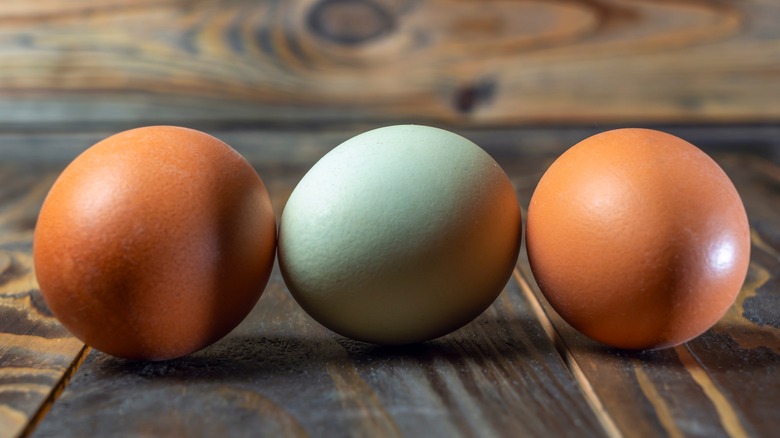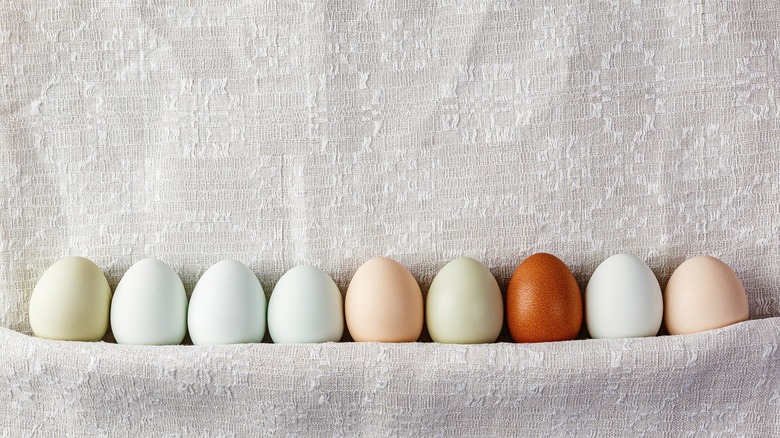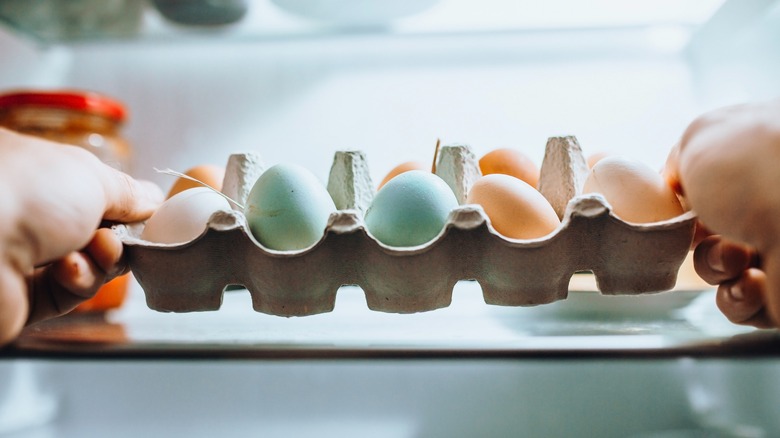How To Find And Cook Blue, Green, Or Pink-Shelled Eggs
Eggs are a lot more colorful than the regular white variety that you mostly see in the supermarket. Sure, there are the brown or "farm fresh" eggs that have become commonplace alongside their plain brethren, but there are also eggs with pastel hues so varied that it's easy to mistake them for Easter decorations. These aren't dyed at all, though; eggshells of blue, green, and pink are colored that way due to natural breeding phenomena.
While the "organic" label seen on packages of brown eggs may lead you to believe that environmental factors influence the color, the reason behind the different colored eggshells has more to do with the breed of hen. White eggs are neither bleached nor the result of chickens being confined. Rather, white eggs are white because the type of chicken that lays them, usually the Leghorn, doesn't have any genes contributing to pigment. On the other hand, chickens that lay brown eggs — or, by the same logic, blue, green, or pink eggs — have pigment genes that determine the color of the eggs they lay.
If you're interested in obtaining some colorful eggs, you might find them at your local farmers market or at some big-name retailers — and don't worry, you can prepare them just as you would regular eggs.
Why do eggs turn different colors?
While the pigment known as protoporphyrin is responsible for brown and pinkish hues, another type of pigment, biliverdin, turns eggs blue and green. This substance is found throughout the animal kingdom, including in insects, fish, and even human bruises. Chickens that produce biliverdin, such as the Araucana, often look as unique as the eggs they lay. Though all eggshells begin as white canvases as they form in the hen's uterus, the pigments specific to each breed contribute to the color. Other factors like diet and stress levels may influence the specific depth of shade, but the base color is a breed-specific phenomenon.
Breeds that produce blue, green, brown, or pink eggs don't lay them as quickly or consistently as chickens that lay white and brown eggs, so they're significantly more difficult to come by. You might be able to scout them out at your local farmers market, but blue eggs, in particular, are becoming more popular for mainstream consumption. Whole Foods sells cartons of them at select stores, and there have been several social media posts from flabbergasted folks who have spotted them at Costco.
Do you cook colored eggs any differently?
There's really no right or wrong way to cook eggs of different colors, such as blue and brown. Since these eggs often come from special "heritage breed" chickens that adhere to guidelines from the American Poultry Association, some people choose to savor them. Higher-quality eggs tend to perform better in baking recipes, especially when whipped in a bowl.
In fact, the hue of an egg's yolk is a more accurate mark of quality and provides a better insight into how the supplying chicken was raised. Darker yolks with a deep orange hue often come from chickens fed on a plant-based diet, typically associated with free-ranging. In contrast, lighter yellow yolks usually indicate that the chickens were fed more wheat. There may be a correlation between non-white eggs and free-range diets, since these chickens are often farmed on a more local scale, but causation is not necessarily implied. The taste differences between colorful eggs and plain ones are also debatable, though many swear that the more colorful an egg is, the better it tastes. However, there's no evidence of a nutritional difference between the two types. You can, however, take pride in the fact that you're likely supporting local farms if you purchase multicolored eggs. Plus, they just look so darn pretty.



